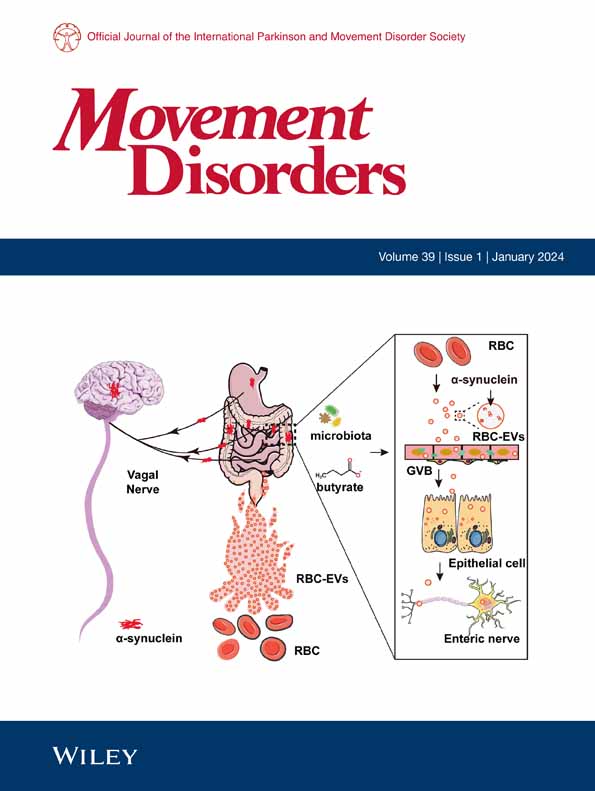Perry综合征中的TDP‐43隐rna:脑区和TDP‐43蛋白病变的差异
IF 7.4
1区 医学
Q1 CLINICAL NEUROLOGY
引用次数: 0
摘要
背景perry综合征(PS)是一种罕见且致命的遗传性常染色体显性神经退行性疾病,由dynactin (DCTN1)突变引起。PS脑积累泛素阳性的包涵体,43 kDa的交互反应DNA结合蛋白(TDP - 43),以及较小程度的动态蛋白。TDP - 43是一种抑制隐外显子包合的RNA结合蛋白,目前对其在PS中的作用知之甚少。因此,我们试图确定TDP - 43在PS大脑两个区域的功能障碍程度。方法对7例PS患者、12例伴有TDP‐43病理的额颞叶变性(FTLD)患者和11例无TDP‐43病理的认知健康对照组的尾状核和黑质中不溶性pTDP‐43和TDP‐43调节的隐rna和蛋白水平进行了检测。结果不溶性pTDP - 43蛋白在PS脑尾状核和黑质中含量相似,但低于FTLD脑。PS的尾状核显示了8种TDP‐43调控的隐性rna (ACTL6B、CAMK2B、STMN2、UNC13A、KCNQ2、ATG4B、GPSM2和HDGFL2)和FTLD特征的隐性蛋白(HDGFL2)的积累。相反,尽管pTDP‐43水平相似,但只有一个隐性靶标UNC13A在黑质中具有显著性。结论在PS尾状核中检测到TDP - 43的隐rna和蛋白。鉴于隐外显子生物学在生物标志物开发和治疗干预新靶点鉴定中的重要性,我们有必要了解不同脑区TDP - 43功能障碍的后果,并确定TDP - 43蛋白病变的特异性和共同靶点。©2025作者。Wiley期刊有限责任公司代表国际帕金森和运动障碍学会出版的《运动障碍》。本文章由计算机程序翻译,如有差异,请以英文原文为准。
TDP‐43 Cryptic RNAs in Perry Syndrome: Differences across Brain Regions and TDP‐43 Proteinopathies
BackgroundPerry syndrome (PS) is a rare and fatal hereditary autosomal dominant neurodegenerative disorder caused by mutations in dynactin (DCTN1 ). PS brains accumulate inclusions positive for ubiquitin, transactive‐response DNA‐binding protein of 43 kDa (TDP‐43), and to a lesser extent dynactin.ObjectivesLittle is known regarding the contributions of TDP‐43, an RNA binding protein that represses cryptic exon inclusion, in PS. Therefore, we sought to identify the degree of TDP‐43 dysfunction in two regions of PS brains.MethodsWe evaluated the levels of insoluble pTDP‐43 and TDP‐43‐regulated cryptic RNAs and protein in the caudate nucleus and substantia nigra of 7 PS cases, 12 cases of frontotemporal lobar degeneration (FTLD) with TDP‐43 pathology, and 11 cognitively healthy controls without TDP‐43 pathology.ResultsInsoluble pTDP‐43 protein levels were detected in PS brains to a similar extent in the caudate nucleus and substantia nigra but lower than those in FTLD brains. The caudate nucleus of PS showed accumulation of eight TDP‐43‐regulated cryptic RNAs (ACTL6B , CAMK2B , STMN2 , UNC13A , KCNQ2 , ATG4B , GPSM2 , and HDGFL2 ) and cryptic protein (HDGFL2) characteristic of FTLD. Conversely, only one cryptic target, UNC13A , reached significance in the substantia nigra despite similar pTDP‐43 levels.ConclusionWe detected TDP‐43 cryptic RNAs and protein in PS caudate nucleus. Given the importance of cryptic exon biology in the development of biomarkers, and the identification of novel targets for therapeutic intervention, it is imperative we understand the consequences of TDP‐43 dysfunction across different brain regions and determine the targets that are specific and common to TDP‐43 proteinopathies. © 2025 The Author(s). Movement Disorders published by Wiley Periodicals LLC on behalf of International Parkinson and Movement Disorder Society.
求助全文
通过发布文献求助,成功后即可免费获取论文全文。
去求助
来源期刊

Movement Disorders
医学-临床神经学
CiteScore
13.30
自引率
8.10%
发文量
371
审稿时长
12 months
期刊介绍:
Movement Disorders publishes a variety of content types including Reviews, Viewpoints, Full Length Articles, Historical Reports, Brief Reports, and Letters. The journal considers original manuscripts on topics related to the diagnosis, therapeutics, pharmacology, biochemistry, physiology, etiology, genetics, and epidemiology of movement disorders. Appropriate topics include Parkinsonism, Chorea, Tremors, Dystonia, Myoclonus, Tics, Tardive Dyskinesia, Spasticity, and Ataxia.
 求助内容:
求助内容: 应助结果提醒方式:
应助结果提醒方式:


